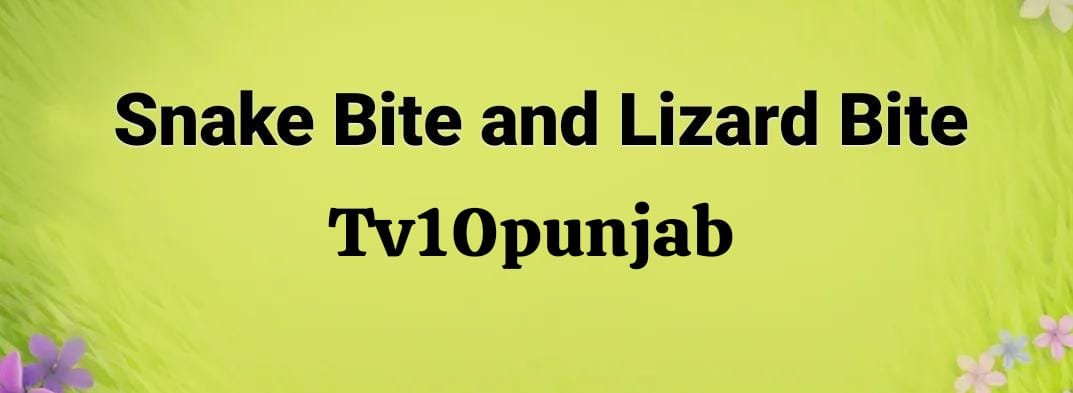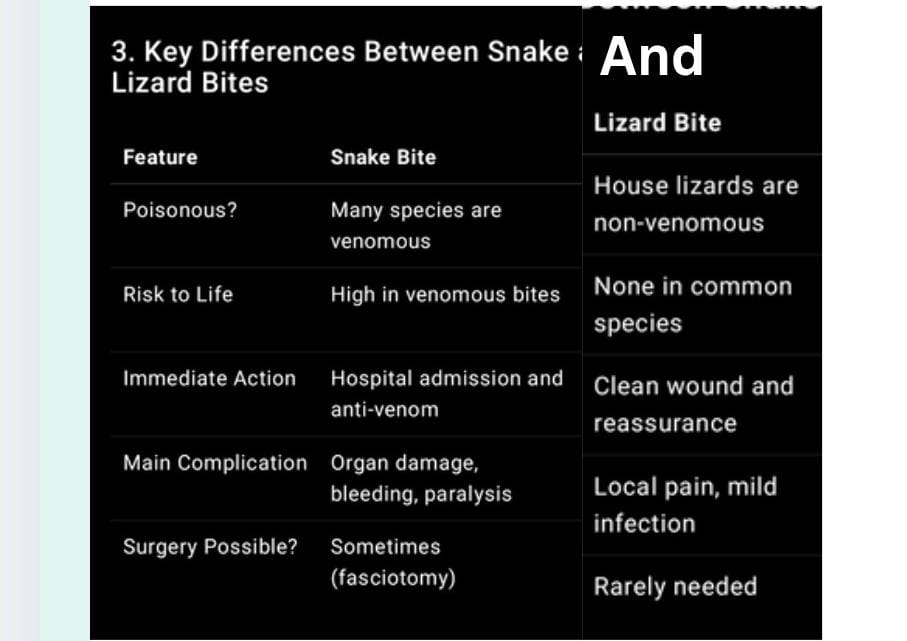Tv10punjab
Health Desk
Snake and lizard bites are different in nature, but both require correct handling and timely medical attention. Snake bites can be life-threatening due to venom, while most lizard bites — especially from common house lizards — are harmless. However, both situations cause fear and confusion in victims. In this article, we will explore everything about snake and lizard bites: causes, symptoms, treatment steps, precautions, and important medical facts.

- Snake Bite
1.1 Understanding Snake Bites
Snake bites happen when a snake injects venom through its fangs into the victim’s body. The severity depends on the type of snake, the amount of venom injected, and the victim’s health condition. Some snakes are non-venomous and cause only minor injury, but venomous snakes can cause serious damage to the body’s nervous system, heart, and muscles.
1.2 First Step – Admit the Patient
When someone is bitten by a snake, the first priority is to get them to a hospital. Time is critical. The faster the treatment starts, the higher the chance of full recovery. Even if the snake is not venomous, it’s better to seek medical help.
1.3 Reassurance is Important
Fear and anxiety increase the heart rate, which can make venom spread faster in the body. Calming the patient is an essential first step. Talking to them in a reassuring tone and ensuring them that they are getting proper care can reduce anxiety.
1.4 IV Line and Monitoring
In the hospital, doctors will insert an intravenous (IV) line to give fluids and medicines directly into the bloodstream. Monitoring vital signs — such as heart rate, blood pressure, breathing rate, and oxygen level — is done continuously for the first 24 hours.
1.5 Anti-Snake Venom (ASV) Infusion
The main treatment for venomous snake bites is anti-snake venom.
Usually, 4 ampules are mixed in 500 ml of a suitable fluid (such as Pladex) and given slowly through an IV line.
Doctors carefully watch for allergic reactions or side effects during the infusion.
Sensitivity tests are not reliable for predicting allergic reactions, so doctors avoid them.
If reactions occur, medical teams are ready with emergency drugs.
1.6 Additional Infusions
Infusion R/L IL IV BD – This refers to giving intravenous fluids to keep the patient hydrated and maintain blood circulation.
Antibiotics – Given if there is an infection at the bite site or if the wound looks contaminated or dead tissue is present.
1.7 Medicines for Specific Conditions
Tab Danzen Forte (Serratiopeptidase) – Helps reduce swelling, given if swelling is present.
Tab Digesic Forte (Dextropropoxyphene + Paracetamol) – For pain and fever.
Proton Pump Inhibitors (PPI) like Risek – Given to prevent stress ulcers, which can occur during hospitalization or due to stress on the body.
1.8 Surgical Considerations
In rare cases, swelling can increase so much that it threatens to cut off blood supply to tissues. This is called compartment syndrome.
A surgery called fasciotomy may be needed to relieve pressure.
The orthopedic department is consulted if swelling continues to grow.
1.9 Investigations
To check the extent of damage and guide treatment, the following tests may be done:
FBC – Full blood count
PT/APPT/INR – Tests for blood clotting
CT & BT – Clotting time and bleeding time
Urine R/E – Urine routine examination
ALT/SGPT – Liver function tests
If clotting time is abnormal, fresh frozen plasma may be given.
1.10 Vitamin K Injection
Vitamin K helps improve blood clotting and may be given for 3 days intravenously.
1.11 Precautions After Snake Bite
No intramuscular (IM) injections for one week — to avoid unnecessary bleeding.
No NSAIDs (like ibuprofen, diclofenac) for one week — as they can increase bleeding risk.
- Lizard Bite
2.1 General Nature of Lizard Bites
Most lizards, especially the wall lizard or gecko found in homes, are harmless to humans. They are not venomous and avoid humans unless threatened.
2.2 When Do Lizards Bite?
Bites usually occur only when:
The lizard is handled roughly
It is cornered and feels threatened
2.3 Reassurance and Counseling
If a patient is bitten by a lizard, they should be reassured that the bite is not poisonous. Fear and stress often cause more discomfort than the bite itself.
2.4 Wound Care
Clean the wound thoroughly with soap and water.
Apply an antiseptic.
If the wound is deep, cover it with a clean dressing.
2.5 Tetanus Prevention
A tetanus injection (TT) may be given to prevent tetanus infection, especially if the wound is open.
2.6 Pain Management
A mild painkiller can be given if there is pain.
3. Key Differences Between Snake and Lizard Bites

- Common Myths and Facts
Myth 1: All snake bites are deadly.
Fact: Many snakes are non-venomous; still, all bites need medical evaluation.
Myth 2: Cutting and sucking venom helps.
Fact: This is dangerous and ineffective. It can spread infection.
Myth 3: Applying a tight tourniquet saves lives.
Fact: It can cause severe tissue damage and worsen the injury.
Myth 4: House lizards are poisonous.
Fact: Common wall lizards are harmless.
- Prevention Tips
For Snake Bites:
Wear shoes when walking in grassy areas.
Use a flashlight at night outdoors.
Avoid putting hands into holes or under rocks.
Keep surroundings clean to prevent rodents (which attract snakes).
For Lizard Bites:
Avoid handling lizards.
Keep home clean and free of insects (lizards’ food).
Close gaps in windows and doors to keep them out.
- Recovery and Prognosis
Snake Bite: Most people recover fully if treated promptly with anti-venom and supportive care.
Lizard Bite: Recovery is usually complete within a few days, with no long-term effects.
- Important Do’s and Don’ts
Do’s:
Keep the victim calm.
Immobilize the bitten limb.
Get medical help immediately.
Don’ts:
Do not give alcohol or caffeine.
Do not apply ice directly to the bite.
Do not cut or suck the wound.
- Final Thoughts
Snake and lizard bites are medical events that need careful handling, but their risks are very different. While snake bites can be life-threatening and need urgent hospital treatment, most lizard bites are harmless and require simple wound care. Public awareness, quick medical help, and correct first aid can save lives and prevent complications.